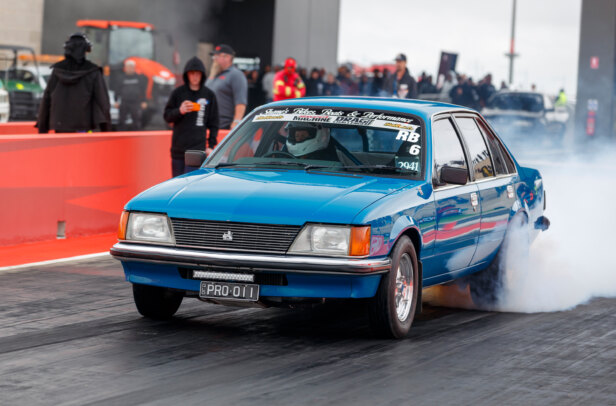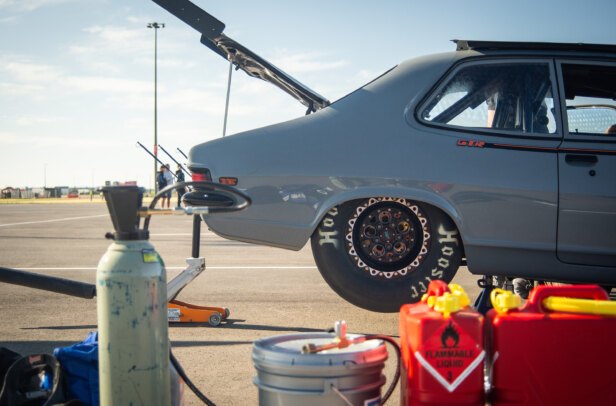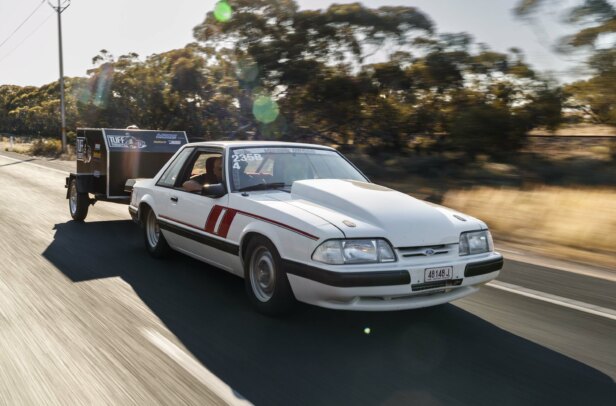With over 100 sets of tyres destroyed to date, the 9000rpm small-block Mopar in Chris Orchard’s VH Commodore, THE GAME, seems the ultimate street and burnout combination – and Chris has never touched the motor.
First published in the February 2024 issue of Street Machine



After hearing a lot about these R5P7 NASCAR mills, the West Australian burnout practitioner got in touch with Brett Niddrie to discuss building one for his VH. “Brett has been working with these engines for a long time, and he knows I’m pretty hard on motors, so he said I could be the test pilot for using them while the blown and injected motor in my VL was getting rebuilt,” Chris explains. “There are a few guys running these combinations, and they love big rpm. Brett had a mate who had one for sale, so I hit him up, and here we are.”
R5P7 engines were initially based off the Chrysler LA platform and used in various NASCAR racing series. They have had millions spent on their development and are just perfect for burnouts, with a multi-stage dry sump and a lightweight rotating assembly comprising a small-stroke crank (3.25in), long rods (6.2in), Honda little-end bearing, 1.85in big-end bearing, and Windsor main bearing.

These motors were all around the 358ci capacity and came with a wide range of head, cam and rocker combinations, and incorporated the best names in performance parts. Traditionally, the mills were replaced after each race with a brand-new one, and for a while, they were very cheap to buy. The later motors produced around 830hp and 500lb-ft of torque, and were capable of revving well above 9000rpm!
Chris could not have found a better guy to build this kind of engine than Brett, who has imported and screwed together countless R5P7 combinations for the race boats he services.
“The motor [in Chris’s car] was an old Evernham that I bought out of the USA,” Brett explains. “It had all the good usual parts – Pankl conrods and Mahle pistons. It was a solid-roller engine, and we tore it down and went through it, eventually fitting it with an APD 1050 carb on 105-octane fuel.

“We always like to dyno our stuff before it leaves the shop, and this one made 820hp and 510lb-ft,” Brett continues. “We also make our own GM transmission conversion kits to bolt up to the Mopar block, with a CNC 16mm sandwich plate and mount for the Mopar starter. We then built a converter with a longer snout to make up for the sandwich plate.”
Brett sent the completed motor and Dedenbear-case Powerglide to Matt James at Unwanted Automotive in WA, who Chris had engaged to complete all the fabrication work on the car, and boy, was there a to-do list.

“We started by notching the rear chassis rails, adding some mini-tubs and strengthening the rear rails,” Matt says. “The car already had a nine-inch, but we shortened and strengthened it, building new chrome-moly control arms and a Panhard bar, adding Viking coil-overs and fitting a new boot floor with tank mounts.
“We are a bit OCD about pipework being symmetrical, so we had to notch the front chassis rails to get in the two-inch exhaust primaries,” Matt continues. “We also had to space the K-frame 15mm lower for oil pan and steering clearance, change to a manual VL steering rack, and mess about with the steering shaft and unis for clearance.”

Other work included mounting the Peterson dry sump tank behind the headlight, which had to be massaged and clearanced for the bonnet. Matt and his team also fitted a jacking bar hidden behind the rear bumper to make it easier to jack the car up, and smoothed the sides of the engine bay.
A chrome-moly trans crossmember was made, incorporating a tailshaft loop. The engine plate supplied with the NASCAR mill looked pretty ordinary, so Matt made a new two-piece item and tied it into the front rails. He also modified the original radiator to work with the Mopar, relocated the battery to the boot, plumbed the engine and car with Speedflow components, added a new MagnaFuel ProStar 500 fuel pump, ditched the original master and booster for a Wilwood master, and replaced the brake lines.

“We decided that as the car was going to sit on the deck, we would fit front coil-overs,” Matt says. The bottom of the stub axle had to be cut off and then reattached, and a 12-litre custom front radiator tank was built, incorporated into the inner guard around the strut tower. A puke tank for the rocker cover breathers was also added.
“As we had fitted bigger wheel tubs, Tyson from Pro Stitch had to modify the rear seat to make it fit, and as the car had already been trimmed, he had to match up the rear trim as well as new carpet and other odds and ends,” Matt explains.

The R5P7 has certainly proved to be the perfect powerplant for Chris’s exploits on the burnout pad. He’s now made it into the Burnout Masters top 10 two years running, finishing second at Street Machine Summernats 36 in a field of super-tough competitors. He qualified with a 9200rpm chip in the limiter, which he then stepped up to 9400rpm for the final. Chris certainly puts 100 per cent into his burnouts, and it’s great to see something other than an LS glued to the limiter on the pad.
Brett reckons the NASCAR mill is only now due for some maintenance, having torched around 100 sets of tyres. “We are just starting to see some wear on the rocker tips [which have Torrington bearings], so it’s probably time to pull it and have a look at it,” he says. “The only advice I try to give Chris is don’t rev it too hard!”



Comments